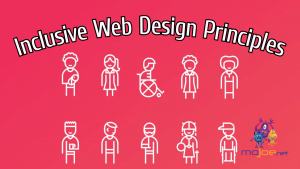Inclusive web design is the process of making design work for previously excluded users, is a concept many like to believe comes naturally. But if we really want to create an inclusive environment, it has to be intentional. One of the challenges of inclusive web design is not changing the content for all types of users, but instead building a space that works for everyone without distorting the content.
This article will cover what you need to know about inclusive web design and how to incorporate these principles into your work process. There are four principles to remember:
- One team, no exclusions.
- The content leads the design.
- Be flexible and provide options.
- Be inclusive from the start.
These principles address four key areas of user experience to ensure that every user has a good experience when visiting your site or application. The end result is a more cohesive look and feels which isn’t jarring for users of all abilities and sensory needs. Inclusive design is for development teams as well as designers and can be adopted by anyone at any stage of the process. Following inclusive design guidelines will help you create sites that are more usable, accessible, better designed and ultimately better for users across the globe.
Users with disabilities, or users who may not have access to the usual methods of interaction, are often overlooked when designing a user experience. A site or application that works well for someone who can use a mouse but fails to account for a user with a motor impairment can exclude and put off users who would otherwise be interested in your content. The inclusive design focuses on accessibility as well as efficiency in this realm, making sure you’re not optimizing one type of user over another.
By working on one team, the inclusive design seeks to make sure everyone is on the same page when it comes to overall goals and direction. Everyone should be working toward the same goal and without excluding any types of users. A team that takes inclusive design seriously will have a better time building an inclusive experience for everyone.
- All features, no exclusions.
- Design for the content, not just the content designers.
- Think of user needs first, then design for them.
- Design for all users from the start.
These four principles are focused on making sure that your application or site can be used well by everyone, regardless of their current abilities or limitations. Where this is easy to apply at times, there are some situations where it starts to become more difficult. In addition to these four principles, we’ll also discuss a few scenarios that frequently come up and tips for making sure you’re acting inclusively at all times.
Inclusive design is an approach, not a series of checkboxes. Just as some people have different ideas about what inclusive design means, each user will have their own unique preferences. Some users may need more time to be able to complete tasks, while others may benefit from alternate input methods like voice or switch access. Some may need larger text than others. Designing your user experience with multiple paths and options ensures that everyone can interact with your product in the way that best suits them.
Want to learn more about getting started with inclusive web design? Inclusive Web Design – Getting Started is a great place to begin.
 If you would like to discuss Your Logo with Mojoe.net or your website’s analytics, custom logo designs, social media, website, web application, need custom programming, or IT consultant, please do not hesitate to call us at 864-859-9848 or you can email us at dwerne@mojoe.net.
If you would like to discuss Your Logo with Mojoe.net or your website’s analytics, custom logo designs, social media, website, web application, need custom programming, or IT consultant, please do not hesitate to call us at 864-859-9848 or you can email us at dwerne@mojoe.net.


Recent Comments